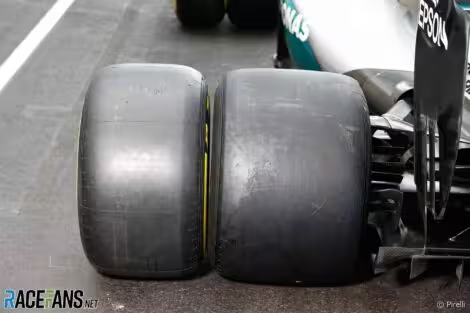Formula 1’s official tyre supplier has warned it will be “impossible” to build mule cars to test the sport’s new rules for 2026.
Pirelli needs to develop a new range for the season after next, when F1 will switch to narrower front and rear wheels. It is part of a drastic overhaul of the technical regulations in which new power units will be introduced and F1 will allow great use of active aerodynamics.
Previously Pirelli has been able to prepare for changes in tyre size using ‘mule cars’ adapted by the teams (pictured above) to simulate the forthcoming new rules. However Pirelli’s motorsport director Mario Isola told RaceFans the nature of F1’s 2026 regulations will largely prevent that.
“It’s impossible, I would say, to create a mule car with similar characteristics,” said Isola. “We will not have smaller cars. We can save some weight – instead of doing long runs with full tanks you can, reduce the level of fuel just to simulate the weight. But for the rest, it’s impossible because you don’t have the active aerodynamics.”
Under the 2026 rules, drivers will be able to switch to a low-downforce mode on straights, then switch back to maximum downforce when cornering.
The 2026 rules will be the third time in 10 years F1 has changed its tyre format. Wider rubber was introduced in 2017, and two years ago F1 switched from 13-inch wheels to 18 inches.
On those occasions teams were able to produce mule cars which approximated the accompanying rules changes. Isola said Pirelli will have to rely heavily on simulation data to develop its 2026 tyres until the first cars arrive at the beginning of the season.
Advert | Become a RaceFans supporter and
“This is a similar situation we faced with the mule cars when we were developing the 18-inch tyre, for example, or during 2016 when we were developing the wider tyre for 2017, also in that case we had mule cars that were not fully representative.
“So what is important for us is to work in parallel with the virtual model and the physical model. We try to understand that which is the correlation between the two in order to have tests on-track that are as much as possible representative of what we will find in 2026, knowing that it will never be 100% representative.”
“For the moment, we have simulations that are coming from the FIA, not yet from the teams,” he added. “But in the in the usual process of development we will receive also…
Click Here to Read the Full Original Article at RaceFans…

